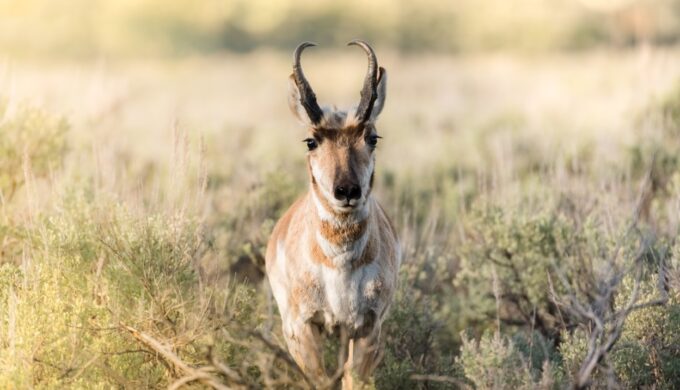
Photo: @chrisfloresfoto via Twenty20
This is NOT an antelope. The animal pictured above is a pronghorn. Some folks call it a pronghorn antelope, or even an American antelope.
Technically, that’s not right. True antelopes live in Africa and Asia. Pronghorns live here in Texas, as well as in some other US states, Mexico, and Canada. So, a pronghorn is NOT an antelope.
Instead, pronghorns are classified by scientists as being in a family all their own. They are related to giraffes, but still are pretty much unique.

Photo: @wjmuchow via Twenty20
Even their horns are special. No other animal sheds their horns, but pronghorns do. Animal horns only have one point, except for pronghorns. Their horns have prongs, like a fork. Deer shed antlers, but antlers are made out of bone, while horns are made out of keratin, which is the same stuff that makes our hair and fingernails.
Pronghorns are also some of the fastest land animals on the planet! They have been clocked running at speeds of over 50 miles an hour. Even when young, pronghorns are fast. A 10-day old pronghorn fawn can easily outrun the average human being.
What’s more, pronghorns have a lot of endurance. They can travel at speeds up to 30 miles an hour for long periods. Most predators don’t have that kind of stamina.
Even cheetahs can only run fast in short bursts. Of course, cheetahs don’t live natively in Texas. So, pronghorns can outrun almost any predator they encounter here.

Photo: @Th0rnw0lf via Twenty20
Unfortunately, they don’t handle barbed-wire fences so well. Unlike deer, pronghorns don’t jump fences. Instead, they try to crawl under a barbed-wire fence and get stopped by the lower wire. So, pronghorns often get stuck on one side of a fence.
Also, pronghorns tend to graze pretty heavily. So, they may eat all the vegetation on one side of a fence and die of malnutrition. There has been a drought going on in some areas of Texas for the last few years, which makes this situation worse.
The Texas government is trying to get property owners to cut the lower wire on a barbed wire fence, or modify the fence in other ways. That way, the pronghorns can cross freely and migrate.

Photo: @kayakarl via Twenty20
Many property owners are cooperating, but some ranchers point out that pronghorns may compete with cattle for grazing plants. Pronghorns eat a lot of plants that cattle can’t stomach, but they also may graze on the same plants that cattle eat. How much competition is there between cattle and pronghorns for food? The short answer is that it depends on what plants are available.
If the area has a lot of different plants, including shrubs, the pronghorns will generally leave the grass alone. However, if all the shrubs and other plants have been removed, then pronghorns may eat grass intended for cattle.
Pronghorns also sometimes graze on farmer’s fields, although they do prefer eating native plants. In the autumn, when native plants have died back, pronghorns may graze wheat and do damage.
It’s not an easy situation to figure out. One possible solution is to modify fencing in places where pronghorns are struggling, while leaving it up in places where they’re doing well.
In Texas, pronghorns seem to be struggling in West Texas and the Marfa Plateau. They may be struggling in West Texas due to drought, along with the fact that they seem to be contracting parasites carried by domestic animals, such as cows and sheep.
Fortunately, pronghorns are doing well in the Texas Panhandle. As a matter of fact, their population has doubled in the last 20 years. There is a limited hunting season in the Panhandle, and a web search shows that hunting pronghorns there is big business.

Photo: @janna.boyd via Twenty20
In Wyoming, until recently, more pronghorns than people lived in the state! That’s good news. The animals are part of our heritage as Americans.
For instance, the Apache tribe refused to hunt pronghorns, because they believed that pronghorns were the embodiment of their ancestors’ spirits.
Other Native American tribes hunted pronghorns, but even with horses, they couldn’t hope to catch the fleet-footed animals. So, most of the time, pronghorns were caught using snares and such.
Lewis and Clark were some of the first folks to document pronghorns, on their first expedition out West. In Clark’s writing, he described the pronghorns as “wild goats or antelopes.” So, Americans have been mistakenly referring to pronghorns as antelopes for a long, long time.
Well, nobody’s perfect.



